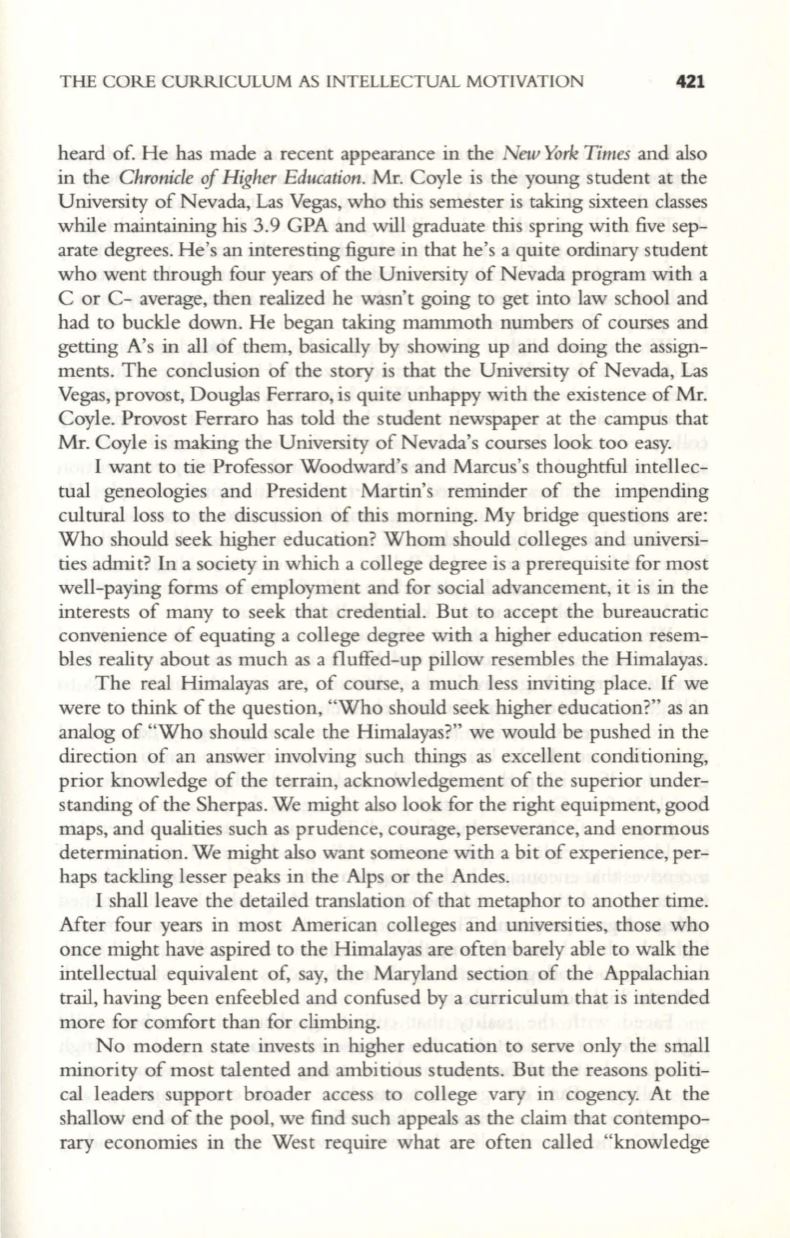
THE CORE CURRICULUM AS INTELLECTUAL MOTIVATION
421
heard of. He has made a recent appearance in the
New York Times
and also
in the
Chronicle
if
Higher Education.
Mr. Coyle is the young student at the
University of Nevada, Las Vegas, who this semester is taking sixteen classes
while maintaining his 3.9 GPA and will graduate this spring with five sep–
arate degrees. He's an interesting figure in that he's a quite ordinary student
who went through four years of the University of Nevada program with a
C or C- average, then realized he wasn't going to get into law school and
had to buckle down. He began taking mammoth numbers of courses and
getting A's in all of them, basically by showing up and doing the assign–
ments. The conclusion of the story is that the University of Nevada, Las
Vegas, provost, Douglas Ferraro, is quite unhappy with the existence of Mr.
Coyle. Provost Ferraro has told the student newspaper at the campus that
Mr. Coyle is making the University of Nevada's courses look too easy.
I want to tie Professor Woodward's and Marcus's thoughtful intellec–
tual geneologies and President Martin's reminder of the impending
cultural loss to the discussion of this morning. My bridge questions are:
Who should seek higher education? Whom should colleges and universi–
ties admit? In a society in which a college degree is a prerequisite for most
well-paying forms of employment and for social advancement, it is in the
interests of many to seek that credential. But to accept the bureaucratic
convenience of equating a college degree with a higher education resem–
bles reality about as much as a fluffed-up pillow resembles the Himalayas.
The real Himalayas are, of course, a much less inviting place. If we
were to think of the question, "Who should seek higher education?" as an
analog of "Who should scale the Himalayas?" we would be pushed in the
direction of an answer involving such things as excellent conditioning,
prior knowledge of the terrain, acknowledgement of the superior under–
standing of the Sherpas. We might also look for the right equipment, good
maps, and qualities such as prudence, courage, perseverance, and enormous
determination. We might also want someone with a bit of experience, per–
haps tackling lesser peaks in the Alps or the Andes.
I shall leave the detailed translation of that metaphor to another time.
Mter four years in most American colleges and universities, those who
once might have aspired to the Himalayas are often barely able to walk the
intellectual equivalent of, say, the Maryland section of the Appalachian
trail, having been enfeebled and confused by a curriculum that is intended
more for comfort than for climbing.
No modern state invests in higher education to serve only the small
minority of most talented and ambitious students. But the reasons politi–
cal leaders support broader access to college vary in cogency. At the
shallow end of the pool, we find such appeals as the claim that contempo–
rary economies in the West require what are often called "knowledge


